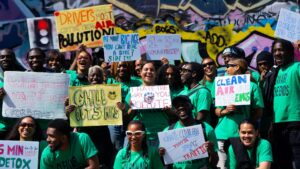Healthy Streets Scorecard have published their 2024 results – recognising London boroughs that are taking steps to make the capital’s streets as welcoming to people as they have, for so long, been to traffic.
Healthy Streets Scorecard is a coalition of campaign which includes Action Vision Zero, Clean Cities Campaign, CPRE London, Future Transport London, London Cycling Campaign, London Living Streets, Possible, Sustrans and Wheels for Wellbeing.
The annually published Scorecard ranks the London Boroughs on how healthy their streets are according to ten indicators:
- Low Traffic Neighbourhoods
- 20mph Speed Limits
- Controlled Parking Zones
- Physically Protected Cycle Track
- School Provision
- Bus Priority
- Sustainable Modeshare
- Active Travel Rate
- Road Collision Casualties
- Car Ownership Rates
The full results appear at the bottom of this page.
The group presented the following five awards to recognise the quality of work being carried out in parts of London.
Overall winner: Islington ‘Taking the top spot from City of London for the first time since the Scorecard began in 2019.’
Top Inner London borough: Islington ‘their rollout of School Streets continues, and the borough has the highest percentage of all schools with a traffic-free School Street. Islington’s pace of rollout of LTNs has slowed but overall coverage continues to increase. The borough also has high levels of delivery on 20mph, bus priority and controlled parking.’
Top Outer London borough: Waltham Forest ‘The north-east London borough is becoming famous, and has recently celebrated their 10-year anniversary of the ‘mini-Holland’ programme. Its schemes from that period are class-leading and continue to set a quality bar the rest of London struggles to match. And it has since gone on year after year to deliver more.’
It was also noted that some boroughs have over-achieved given their housing density, as the more densely populated boroughs have an advantage. To acknowledge this, the Scorecard also shows the actual scores boroughs achieve compared to the score they were predicted to achieve based on their housing density.
Inner London Borough outscoring on housing density: Camden ‘Camden is a high-performing inner London borough on the Scorecard year after year, but it notably delivers beyond its expected score when adjusted for density compared to other inner London boroughs.’
Outer London borough outscoring on housing density: Richmond ‘Richmond is a relatively affluent and low-density outer London borough but far outperforms similar boroughs on delivery of Healthy Streets measures. Its delivery of 20mph speed limits on borough-controlled roads is particularly impressive.’
In contrast to the above accolades, the report does not take a particularly positive view of the overall work done to create liveable streets in London.
‘Tracking the boroughs across their actions and schemes over the last six years,’ the report observes, ‘campaigners see too few beacon boroughs rolling out healthy streets schemes and too many simply doing nothing. The 2024 Healthy Streets Scorecard shows most boroughs have done little or nothing this past year. Just a handful of boroughs are making any progress at all.’
The report examines the performance of the Mayor’s Transport Strategy and in most cases finds that what progress has been made is not enough. In some areas such as car use/traffic and bus speeds, things are heading in the wrong direction entirely.
As a result of their findings The Healthy Streets Coalition has published a set of interventions which they believe will get London back on track. These include suggestions to improve bus speeds, promote car clubs and take action on the increasing number of vans in the capital.
More ambitions suggestions include: ‘delivering a healthy streets audit of the entire TfL Road Network (Red Routes), with a sustainable kerbside strategy and a ringfenced fund to deliver safe, accessible and attractive town centres and high streets across London’ and a call for a ‘transformational change in the landscape for walking and cycling.’
To limit traffic, the group also call for Smart Road User Charging, a Zero Emission Zone or an expanded Congestion Zone, as well as consideration be given to car -free Sundays or a car-free West End.
















Leave a Reply